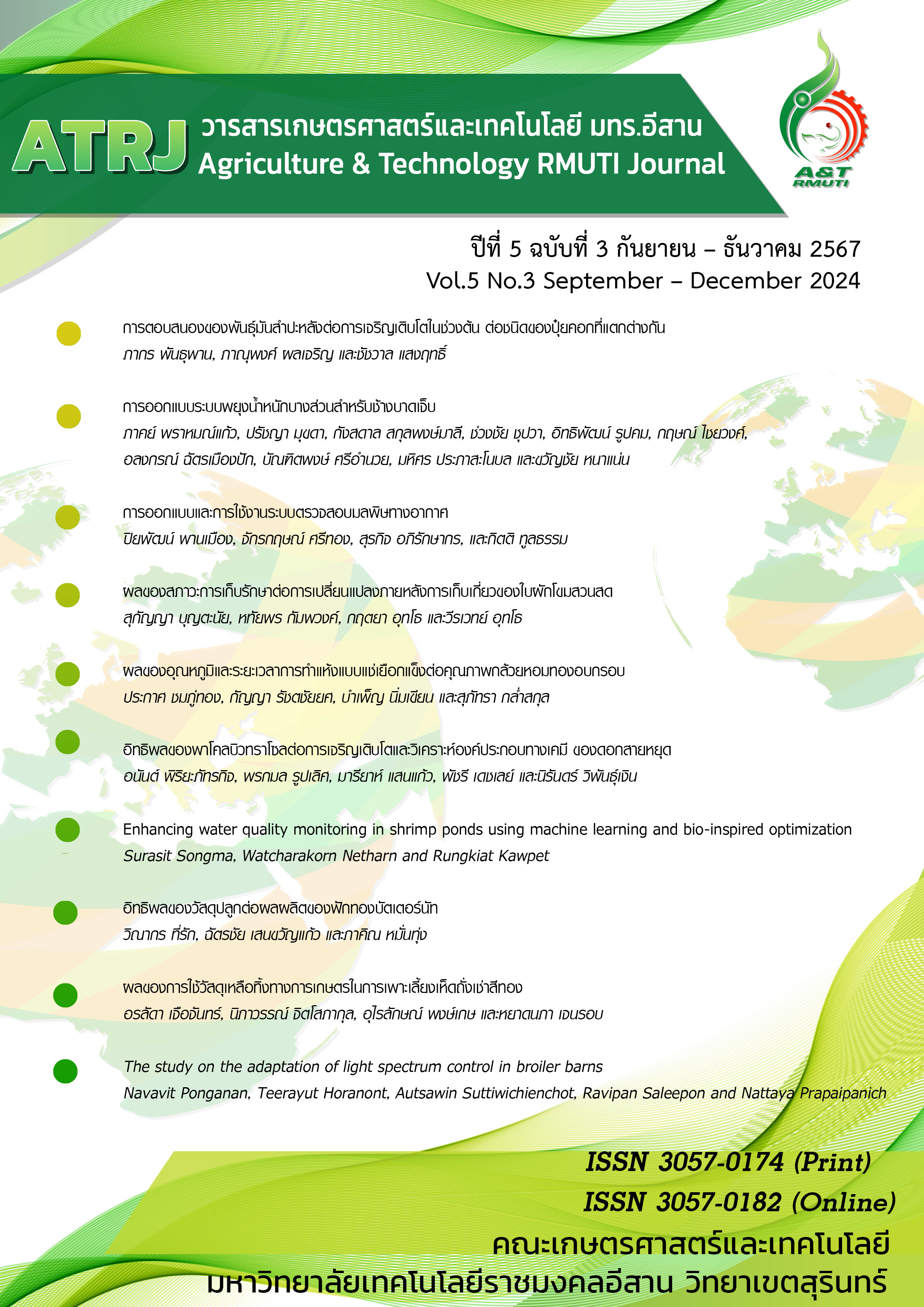การตอบสนองของพันธุ์มันสำปะหลังต่อการเจริญเติบโตในช่วงต้น ต่อชนิดของปุ๋ยคอก ที่แตกต่างกัน
คำสำคัญ:
ปุ๋ยอินทรีย์, พืชพลังงาน, มันสำปะหลัง, อัตราการเจริญเติบโตบทคัดย่อ
ปัจจุบันผู้บริโภคให้ความสนใจในอาหารเพื่อสุขภาพมากขึ้น การเลือกชนิดปุ๋ยคอกที่เหมาะสมกับพันธุ์จะเป็นแนวทางในการผลิตอาหารปลอดภัยได้ การศึกษานี้มีวัตถุประสงค์เพื่อศึกษาผลของปุ๋ยคอกชนิดต่างๆ ต่อการเจริญเติบโตในช่วงต้นของมันสำปะหลัง 3 พันธุ์ โดยออกแบบการทดลองแบบ factorial in completely randomized design (CRD) ปัจจัยที่ศึกษา ได้แก่ ชนิดปุ๋ย 4 ชนิด (ไม่ใส่ปุ๋ยคอก, ปุ๋ยมูลไก่, มูลสุกร, และมูลโค) และพันธุ์มันสำปะหลัง 3 พันธุ์ (ระยอง 9, ระยอง 11 และเกษตรศาสตร์ 50) ทำการทดลองในกระถางจำนวน 4 ซ้ำ ภายใต้สภาพโรงเรือนสาขาวิชาพืชศาสตร์ คณะเกษตรและเทคโนโลยี มหาวิทยาลัยนครพนม โดยทำการวิเคราะห์คุณสมบัติดินก่อนปลูก และใส่ปุ๋ยคอกในอัตรา 500 กก./ไร่ เมื่อมันสำปะหลังมีอายุ 30 วันหลังปลูก ทำการเก็บข้อมูลที่อายุ 30, 60 และ 90 วันหลังปลูก ผลการทดลองพบว่า การใช้ปุ๋ยมูลไก่ส่งผลให้น้ำหนักแห้งรวมและน้ำหนักรากสะสมอาหารสูงที่สุด พันธุ์ระยอง 9 มีน้ำหนักแห้งรวม น้ำหนักแห้งต้น และน้ำหนักแห้งรากสะสมอาหารสูงที่สุด พบปฏิกิริยาสัมพันธ์ระหว่างการใช้ปุ๋ยมูลไก่ในพันธุ์ระยอง 9 โดยส่งผลให้มีมวลชีวภาพ น้ำหนักแห้งรากสะสมอาหารและน้ำหนักแห้งต้น ที่อายุ 60 และ 90 วันหลังปลูก และอัตราการเจริญเติบโตในช่วง 30–60 วันหลังปลูก สูงที่สุด ในขณะที่การใช้ปุ๋ยมูลสุกรในพันธุ์ระยอง 11 ทำให้มีน้ำหนักแห้งใบที่อายุ 60 และ 90 วันหลังปลูก และอัตราการเจริญเติบโตของใบในช่วง 30–60 และ 60–90 วันหลังปลูก สูงที่สุด ข้อมูลเหล่านี้สามารถนำไปใช้เป็นแนวทางในการปลูกมันสำปะหลังแบบอินทรีย์ได้
References
ไพฑูรย์ ฟักเขียว. (2557). การศึกษาระบบการเพาะปลูกเพื่อเพิ่มผลผลิตมันสำปะหลัง. วารสารวิจัย มหาวิทยาลัยสวนดุสิต. 7(3): 93–102.
สำนักงานเศรษฐกิจการเกษตร. (2565). สถิติการค้าสินค้าเกษตรไทยกับต่างประเทศ ปี 2565. สำนักงานเศรษฐกิจการเกษตร กระทรวงเกษตรและสหกรณ์: กรุงเทพมหานคร.
สำนักงานเศรษฐกิจการเกษตร. (2566). สถานการณ์สินค้าเกษตรที่สำคัญและแนวโน้มปี 2566. สำนักงานเศรษฐกิจการเกษตร กระทรวงเกษตรและสหกรณ์: กรุงเทพมหานคร.
Analytical Software. (2013). Statistix, version 10. Analytical Software: Tallahassee.
Bakayoko S., Soro D., Nindjin C., Dao D., Tschannen A., Girardin O. and Assa A. (2009). Effects of cattle and poultry manures on organic matter content and adsorption complex of a sandy soil under cassava cultivation (Manihot esculenta, Crantz). African Journal of Environmental Science and Technology. 3(8): 190–197.
Biratu G.K., Elias E., Ntawuruhunga P. and Nhamo N. (2018a). Effect of chicken manure application on cassava biomass and root yields in two agro–ecologies of Zambia. Agriculture. 8(4): 45.
Biratu G.K., Elias E., Ntawuruhunga P. and Sileshi G.W. (2018b). Cassava response to the integrated use of manure and NPK fertilizer in Zambia. Heliyon. 4(8): e00759.
Bremner J.M. (1965). Total nitrogen. In Norman A.G., Editor. Methods of Soil Analysis: Part 2 Chemical and Microbiological Properties. Soil Science Society of America: Madison. 1149–1178
Chapman H.D. (1965). Cation–exchange capacity. In Norman A.G., Editor. Methods of Soil Analysis: Part 2 Chemical and Microbiological Properties. Soil Science Society of America: Madison. 891–901.
Diacono M. and Montemurro F. (2011). Long-term effects of organic amendments on soil fertility. In Lichtfouse E., Hamelin M., Navarrete M., Debaeke P., Editors. Sustainable agriculture volume 2. Springer Science & Business Media: Heidelberg. 761-786.
El–Sharkawy M.A. (2006). International research on cassava photosynthesis, productivity, eco–physiology, and responses to environmental stresses in the tropics. Photosynthetica. 44: 481–512.
Food and Agriculture Organization of the United Nations. (2018). Food Outlook–Biannual Report on Global Food Markets–November 2018. Food and Agriculture Organization of the United Nations: Rome.
Fukai S., Alcoy A.B., Llamelo A.B. and Patterson R.D. (1984) Effects of solar radiation on growth of cassava (Manihot esculenta Crantz.). I. Canopy development and dry matter growth. Field Crops Research. 9: 347–360.
Gomez K.A. and Gomez A.A. (1984). Statistical Procedures for Agricultural Research. John Wiley and Sons: New York.
Howeler R.H. (2013). Save and Grow: Cassava, A guide to sustainable production intensification. Food and Agriculture Organization of the United Nations: Rome.
Jackson M.L. (1973). Soil chemical analysis. Pentice hall of India Pvt. Ltd.: New Delhi.
Janket A., Vorasoot N., Toomsan B., Kaewpradit W., Theerakulpisut P, Holbrook C.C., Kvien C.K., Jogloy S. and Banterng P. (2020a). Accumulation dynamics of starch and its granule size distribution of cassava genotypes at different growing seasons. Agriculture. 10(9): 380.
Janket, A., Vorasoot N., Toomsan B., Kaewpradit W., Jogloy S., Theerakulpisut P., Holbrook C.C., Kvien C.K. and Banterng P. (2020b). Starch accumulation and granule size distribution of cassava cv. Rayong 9 grown under irrigated and rainfed conditions using different growing seasons. Agronomy. 10(3): 412.
Mahakosee S., Jogloy S., Vorasoot N., Theerakulpisut P., Banterng P., Kesmala T., Holbrook C. and Kvien C. (2019). Seasonal variations in canopy size and yield of Rayong 9 cassava genotype under rainfed and irrigated conditions. Agronomy. 9: 362.
Mahakosee S., Jogloy S., Vorasoot N., Theerakulpisut P., Holbrook C.C., Kvien, C.K. and Banterng P. (2020). Seasonal variation in canopy size, light penetration and photosynthesis of three cassava genotypes with different canopy architectures. Agronomy. 10(10): 1554.
Malik A.I., Kongsil P., Nguyễn V.A., Ou W., Srean P., López–Lavalle L.A.B., Utsumi Y., Lu C., Kittipadakul P., Nguyễn H.H., Ceballos H., Nguyễn T.H., Gomez M.S., Aiemnaka P., Labarta R., Chen S., Amawan S., Sok S., Youabee L., Seki M., Tokunaga H., Wang W., Li K., Nguyễn H.A., Nguyễn V.D., Hàm L.H. and Ishitani M. (2020). Cassava breeding and agronomy in Asia: 50 years of history and future directions. Breeding science. 70(2): 145–166.
Mathias L. and Kabambe V.H. (2015). Potential to increase cassava yields through cattle manure and fertilizer application: results from Bunda College, Central Malawi. African Journal of Plant Science. 9(5): 228–234.
Odedina J.N., Odedina S.A. and Ojeniyi S.O. (2011). Effect of types of manure on growth and yield of cassava (Manihot esculenta, Crantz). Researcher. 3(5): 1–8.
Phoncharoen P., Banterng P., Vorasoot N., Jogloy S., Theerakulpisut P. and Hoogenboom G. (2019a). Growth rates and yields of cassava at different planting dates in a tropical savanna climate. Scientia Agricola. 76: 376–388.
Phoncharoen P., Banterng P., Vorasoot N., Jogloy S., Theerakulpisut P. and Hoogenboom G. (2019b). The impact of seasonal environments in a tropical savanna climate on forking, leaf area index, and biomass of cassava genotypes. Agronomy. 9(1): 19.
Phuntupan K., and Banterng P. (2017). Physiological determinants of storage root yield in three cassava genotypes under different nitrogen supply. The Journal of Agricultural Science. 155(6): 978–992.
Prammanee S., Kamprerasart K., Salakan S. and Sriroth K. (2010). Growth and starch content evaluation on newly released cassava cultivars, Rayong 9, Rayong 7 and Rayong 80 at different harvest times. Agriculture and Natural Resources. 44(4): 558–563.
Ramanujam T. (1985). Leaf density profile and efficiency in partitioning dry matter among high and low yielding cultivars of cassava (Manihot esculenta Crantz). Field Crops Research. 10: 291–303.
Rhoades J.D. and van Schilfgaarde J. (1976). An electrical conductivity probe for determining soil salinity. Soil Science Society of America Journal. 40(5): 647–651.
Santanoo S., Vongcharoen K., Banterng P., Vorasoot N., Jogloy S., Roytrakul S. and Theerakulpisut P. (2019). Seasonal variation in diurnal photosynthesis and chlorophyll fluorescence of four genotypes of cassava (Manihot esculenta Crantz) under irrigation conditions in a tropical savanna climate. Agronomy. 9(4): 206.
Santanoo S., Vongcharoen K., Banterng P., Vorasoot N., Jogloy S., Roytrakul S. and Theerakulpisut P. (2022). Physiological and proteomic responses of cassava to short–term extreme cool and hot temperature. Plants. 11(17): 2307.
Sawatraksa N., Banterng P., Jogloy S., Vorasoot N. and Hoogenboom G. (2018). Chlorophyll fluorescence and biomass of four cassava genotypes grown under rain–fed upper paddy field conditions in the tropics. Journal of Agronomy and Crop Science. 204(6): 554–565.
Sawatraksa N., Banterng P., Jogloy S., Vorasoot N. and Hoogenboom G. (2019). Cassava growth analysis of production during the off–season of paddy rice. Crop Science. 59(2): 760–771.
Vongcharoen K., Santanoo S., Banterng P., Jogloy S., Vorasoot N. and Theerakulpisut P. (2018). Seasonal variation in photosynthesis performance of cassava at two different growth stages under irrigated and rain–fed conditions in a tropical savanna climate. Photosynthetica. 56(4): 1398–1413.
Vongcharoen K., Santanoo S., Banterng P., Jogloy S., Vorasoot N. and Theerakulpisut P. (2019). Diurnal and seasonal variations in the photosynthetic performance and chlorophyll fluorescence of cassava ‘Rayong 9’under irrigated and rainfed conditions. Photosynthetica. 57(1): 268–285.
Walkley A. and Black I.A. (1947). Determination of organic matter in the soil by chromic acid digestion. Soil Science. 63: 251–264.
Wongnoi S., Banterng P., Vorasoot N., Jogloy S. and Theerakulpisut P. (2020). Physiology, growth and yield of different cassava genotypes planted in upland with dry environment during high storage root accumulation stage. Agronomy. 10(4): 576.
Downloads
เผยแพร่แล้ว
How to Cite
ฉบับ
บท
License
Copyright (c) 2024 วารสารเกษตรศาสตร์และเทคโนโลยี มทร.อีสาน

This work is licensed under a Creative Commons Attribution-NonCommercial-NoDerivatives 4.0 International License.
เนื้อหาและข้อมูลในบทความที่ลงตีพิมพ์ในวารสารทดสอบระบบ ThaiJo2 ถือเป็นข้อคิดเห็นและความรับผิดชอบของผู้เขียนบทความโดยตรงซึ่งกองบรรณาธิการวารสาร ไม่จำเป็นต้องเห็นด้วย หรือร่วมรับผิดชอบใดๆ
บทความ ข้อมูล เนื่อหา รูปภาพ ฯลฯ ที่ได้รับการดีพิมพ์ในวารสารทดสอบระบบ ThaiJo2 ถือเป็นลิขสิทธิ์ของวารสารทดสอบระบบ ThaiJo2 หากบุคคลหรือหน่วยงานใดต้องการนำทั้งหมดหรือส่วนหนึ่งส่วนใดไปเผยแพร่หรือเพื่อกระทำการใดๆ จะต้องได้รับอนุญาตเป็นลายลักอักษรณ์จากวารสารทดสอบระบบ ThaiJo2 ก่อนเท่านั้น






